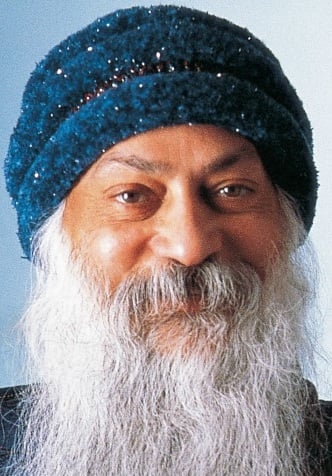PERSONAL INFORMATION
Real Name: Chandra Mohan Jain
Nickname: Acharya Rajneesh, Osho
Profession: Mystic, Spiritual Teacher and Leader of The Rajneesh Movement
Date of Birth: 11 December 1931
Age (at the time of death): 58 Years
Zodiac Sign: Sagittarius
Nationality: Indian
Hometown: Bareli, Madhya Pradesh
Religion: Hinduism
Check Out Other Celebrities Biography
- tarsem jassar punjabi singer biography
- anveshi jain biography
- jay bhanushali biography
- anu aggarwal biography
- camila andrade biography
EDUCATION
School: Not Known
College: Hitkarini College, Jabalpur D. N. Jain College, Jabalpur Sagar University, Sagar(Madhya Pradesh)
Educational Qualification: M.A. Philosophy
FAMILY & RELATIONSHIPS
Family: Father – Babulal Jain (Sw Devateerth Bharti) (Mar 21, 1908-Sep 8, 1979) Mother – Saraswati Bai Jain (Ma Amrit Saraswati) (Nov 23, 1913-May 17, 1995) Brothers – Vijay Kumar Khate, Shailendra Shekhar, Amit Mohan Khate, Aklank Kumar Khate, Niklank Kumar Jain Sisters – Rasa Kumari, Snehlata Jain, Nisha Khate, Neeru Singhai
Marital Status: Unmarried
Affairs/Girlfriends: Sheela Ambalal Patel or Ma Anand Sheela Ma Prem Nirvano (Ma Yoga Vivek) (Allegedly)
MONEY FACTOR
Net Worth: $45 million (Rs.4.5 crore)
OTHER INFORMATION
Birth Place: Kuchwada Village, Bareli Tehsil, Raisen, Madhya Pradesh
Date of Death: 19 January 1990
Place of Death: Pune, Maharashtra, India
Death Cause: Heart Failure
Address: Osho International Meditation Resort, 17 Koregaon Park, Pune
INTERESTING BACKGROUND INFORMATION
Osho, originally named Rajneesh, was a profound figure in the realm of spirituality and meditation, known for his distinct approach to philosophy and human experience. Born into a family of Taranapanthi Jains engaged in the cloth merchandise business, he spent his formative years under the watchful eye of his maternal grandparents, who nurtured his spirit of freedom until he was seven. This early period significantly shaped his personality, allowing him to thrive in an environment devoid of conventional educational pressures. Following the death of his grandfather, Osho relocated to Gadarwara, Madhya Pradesh, where his unique abilities as a gifted student and debater began to flourish. His college years saw him developing a keen interest in hypnosis and antitheism, as well as engaging with various nationalist organizations, although he soon distanced himself from them.
At nineteen, Osho commenced his studies at Hitkarini College in Jabalpur, later transferring to D. N. Jain College. His argumentative nature often led to conflicts in class, resulting in his eventual dismissal from formal attendance while still being allowed to sit for examinations. Despite the challenges, he took on a role as an assistant editor at a local newspaper during his free time. His engagement in annual Sarva Dharma Sammelans reflected his deepening involvement in spiritual discussions. Osho’s parents’ desire for him to marry was met with resistance, and on March 21, 1953, he experienced a pivotal enlightenment under a tree in Bhanvartal garden. Following this transformative experience, he graduated with a Master’s degree in philosophy in 1957 and began teaching at Sanskrit College in Raipur, although concerns about his moral influence on students led to his transfer.
The 1960s marked a significant expansion of Osho’s reach as he traveled across India, becoming a vocal critic of Mahatma Gandhi, socialism, and Hindu orthodoxy. He initiated meditation camps that flourished into the Jivan Jagruti Andolan, promoting a refreshing understanding of spirituality that resonated particularly well with the younger generation in the West. By 1970, he had adopted the title “Bhagwan Shree Rajneesh” and moved to Mumbai, where he continued to lecture extensively. His ashram in Pune, established in 1974, became a hub for meditation and self-exploration, attracting followers and creating significant income through therapy groups inspired by the Human Potential Movement. Amidst this backdrop of expansion, Osho embraced a luxurious lifestyle that earned him the titles of “Sex Guru” in India and the “Rolls-Royce Guru” in the United States, reflecting his open attitude towards human sexuality and wealth.
Osho’s journey took a tumultuous turn when he moved to the United States in 1981 to establish his ashram in Oregon, known as Rajneeshpuram. However, legal challenges loomed large, and in April of that year, he entered a self-imposed silence for over three years. This period was marked by introspection and a focus on spiritual teachings. His relationship with the media soured in 1985 when he publicly denounced his secretary and her actions, ultimately leading to his deportation from the U.S. He returned to his ashram in Pune, where he continued to develop innovative meditation techniques, including the “Mystic Rose” and several dynamic practices designed to foster self-awareness. As a prolific writer, Osho authored over 650 books, delving into the intricacies of human existence and spirituality, leaving a lasting impact that continued to grow even after his death on January 19, 1990, from heart failure.
In the years following his passing, perceptions of Osho evolved significantly. His life and teachings sparked renewed interest, with ashrams multiplying around the world and a growing number of disciples embracing his philosophies. Recognized by notable figures such as former Indian Prime Minister Manmohan Singh, Osho’s legacy persists through various platforms, including stress management seminars for corporate clients organized by The Osho International Foundation. His life inspired numerous documentaries and biographical films, the most notable being “The Rebellious Flower,” which captures his journey and insights. In the present day, the Osho International Meditation Resort in Pune continues to attract seekers, albeit with the unique requirement of an HIV test for entry, a reflection of his ongoing influence in the spiritual landscape.
—
Note: All biographical information compiled from publicly available sources.
